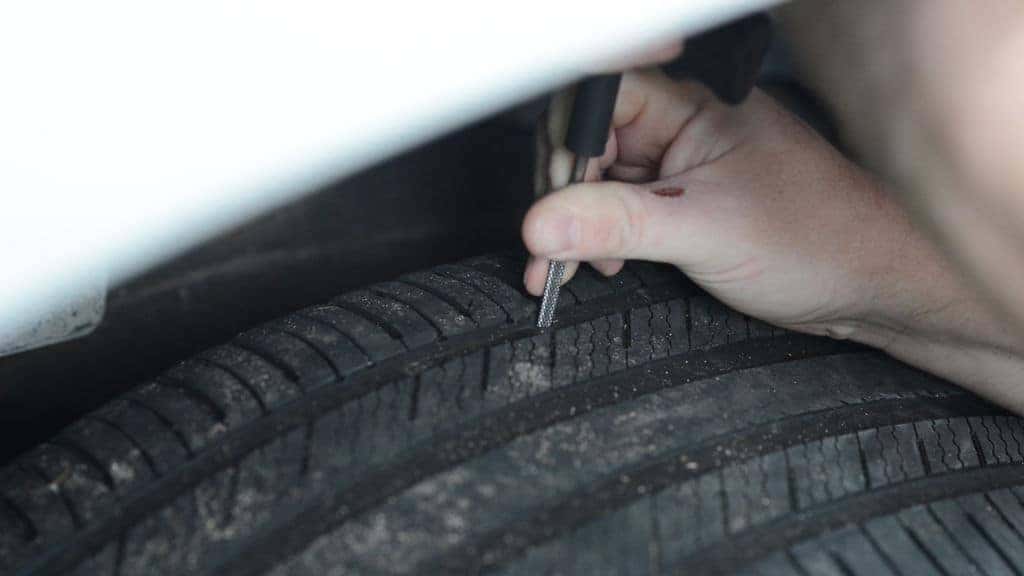As an Amazon Associate, I earn from qualifying purchases at no extra cost to you.
What Should I Do If There’S a Nail in My Tire But It’S Not Flat?
If you have a nail in your tire but it’s not flat, it’s important to get it inspected and repaired promptly to prevent a future flat tire. While you may not see an immediate issue, leaving the nail unrepaired can lead to a slow leak or worsen the damage over time.
Ignoring it could result in a sudden flat tire, posing a safety risk while driving. Getting the nail removed and tire inspected by a professional will help prevent potential problems and ensure your safety on the road. Taking action promptly will save you from more costly and inconvenient repairs down the line.
Remember, it’s better to address the issue proactively to avoid any unforeseen tire-related issues.

Credit: www.autodrx.com
Assessing The Situation
It can be quite unnerving to discover a nail in your tire, even if it doesn’t appear to be flat. However, it’s important not to panic and instead assess the situation carefully. By following these simple steps, you can determine the severity of the issue and take appropriate action to prevent any further damage to your tire.
Identifying The Presence Of A Nail
While it may seem obvious, the first step in assessing the situation is to confirm that there is indeed a nail lodged in your tire. Inspect the tire visually, looking for any signs of a nail sticking out or embedding itself into the rubber. If you notice a foreign object of this nature, chances are high that it is the cause of your concern.
Checking Tire Pressure
To ensure that the nail hasn’t compromised the integrity of your tire, it’s crucial to check the tire pressure. Use a tire pressure gauge to measure the air pressure in the affected tire, comparing it to the recommended pressure indicated by the vehicle manufacturer. If the pressure is within the acceptable range, it indicates that the nail hasn’t caused a significant leak, and your tire is still safe to drive on.
However, if the tire pressure is lower than it should be, it could indicate a slow leak caused by the nail. In this case, it’s essential to proceed cautiously and address the issue promptly. Avoid driving long distances or at high speeds as it can further damage the tire or even result in a sudden blowout.
Consider consulting a professional tire technician to assess the extent of the damage and determine the best course of action to fix or replace the tire.
Additional Precautions
While assessing the situation, it’s crucial to remember a few additional precautions to ensure your safety and minimize further damage. Here are some useful tips:
- Do not attempt to remove the nail yourself, as you may unintentionally cause more harm. Leave it to the professionals who have the necessary tools and knowledge to handle the situation safely.
- Avoid driving over rough or debris-filled roads to reduce the risk of the nail piercing deeper into the tire or causing additional damage.
- Regularly monitor the tire pressure in the affected tire, as a slow leak may eventually cause it to go flat. Maintaining the proper tire pressure is essential for safe and efficient driving.
By following these guidelines and taking the appropriate steps to assess the situation, you can effectively manage a nail in your tire and prevent any further issues on the road. Remember, when in doubt, consult with a tire professional to ensure your safety and maintain optimal performance of your vehicle.
Understanding The Risk
When you discover a nail in your tire that isn’t causing it to go flat, it’s essential to understand the risks associated with driving under such circumstances.
Potential Tire Damage
Driving with a nail in your tire can lead to further punctures or a blowout.
Safety Concerns
Continuing to drive with a nail in your tire poses a risk to your safety and that of others.
Also Read: How to Remove Rust from a Wheel Hub?
Deciding Whether To Remove The Nail
When faced with a nail in your tire that is not causing a flat, the decision to remove it requires careful consideration. Assessing the potential risks and benefits of extraction is crucial to determining the best course of action.
Considering The Location Of The Nail
Identifying where the nail is lodged in the tire is pivotal. Nails near the edges can lead to quicker leaks, whereas those in the center may pose less imminent danger.
Assessing The Tire’s Wear
Examining the overall condition of the tire is essential. An old or worn-out tire may not withstand the removal process and could lead to further damage.
Seeking Professional Assistance
If you discover a nail in your tire but it’s not flat, seeking professional assistance is crucial. Professional help can accurately assess the situation to prevent potential tire damage or hazards on the road, ensuring your safety while driving.
Consulting A Mechanic
If you have discovered a nail in your tire but it’s not flat, seeking professional assistance is crucial to ensure your safety on the road. A qualified mechanic can accurately assess the situation and recommend the appropriate course of action. Avoid the temptation to remove the nail yourself, as this could potentially cause further damage or compromise the integrity of the tire. Instead, trust the expertise of a mechanic who can provide a professional evaluation and offer the most suitable solution.Evaluating Repair Options
Once you consult a mechanic, they will evaluate the extent of the damage caused by the nail and present you with different repair options. It’s important to carefully consider their recommendations, as each option carries its own advantages and disadvantages. Here are some common repair options that a mechanic might suggest:- Tire Patch: In cases where the nail has not caused significant damage, a tire patch may be a viable solution. This involves removing the nail, inspecting the tire for any internal damage, and applying a patch to seal the hole.
- Tire Plug: If the nail hasn’t punctured the tire sidewall and the damage is minimal, a tire plug is another potential option. A mechanic will remove the nail, ream the hole to create a smooth opening, and insert a plug that effectively seals the puncture.
- Tire Replacement: In situations where the nail has caused irreversible damage or if the tire is already worn out, a complete tire replacement might be recommended. This ensures your safety and prevents any potential blowouts or further complications down the road.
- Tire Rotation: Depending on the wear and tear of your existing tires, a mechanic might recommend rotating the affected tire to a different position on your vehicle. This can help distribute the load evenly and extend the overall lifespan of your tires.
Preventative Measures
If you’ve discovered a nail in your tire but it’s not flat, taking preventative measures can help prevent a potential blowout or larger issues down the road. By addressing the issue now, you can help maintain the integrity of your tire and ensure your safety on the road.
Using Tire Sealant Products
Tire sealant products can provide a quick and temporary solution if you’ve discovered a nail in your tire. These products can help seal small punctures caused by nails and prevent air from escaping, allowing you to drive the vehicle to a safe location for a proper repair.
Regular Tire Inspections
Regular tire inspections are vital for catching potential issues like nails embedded in the tire before they lead to a flat tire. Inspecting your tires at least once a month can help you identify any foreign objects that may have punctured the rubber, allowing you to address the issue before it escalates.

Credit: www.reddit.com
Emergency Preparedness
When driving, encountering a nail in your tire is a common inconvenience. It’s important to be prepared for such situations to ensure you can handle them quickly and effectively. Having the right knowledge and tools at your disposal can make a significant difference in how you address this issue.
Carrying A Tire Repair Kit
Carrying a tire repair kit is an essential part of being prepared for tire punctures. These kits typically contain items such as a tire plug and reamer, a tire pressure gauge, and a small air compressor. Investing in a quality repair kit can provide peace of mind and help you perform a temporary fix should you encounter a nail in your tire.
Understanding Temporary Fixes
Understanding temporary fixes can also be beneficial in situations where a nail is present in your tire. Being able to safely plug a tire can allow you to continue driving to a nearby service station for a more permanent repair. However, it’s crucial to understand that these fixes are temporary and should not be relied upon for extended periods or at higher speeds.
Long-term Solutions
Discovering a nail in your tire can be a frustrating experience, but it doesn’t always have to result in a flat tire. In some cases, the presence of a nail might go unnoticed as your tire remains unaffected. While it may seem tempting to ignore the issue altogether, it is important to consider long-term solutions to ensure your safety on the road. This article will explore two essential aspects: tire replacement considerations and maintaining safe driving practices.
Tire Replacement Considerations
If the nail in your tire doesn’t cause any immediate damage, you might still need to consider tire replacement in the long run. Here are some important factors to keep in mind:
| Considerations | Action |
|---|---|
| Age of the tire | Inspect the tire and assess its overall condition. If it is already nearing the end of its lifespan, a replacement may be necessary. |
| Location of the nail | If the nail is close to the sidewall or in an area that cannot be repaired safely, tire replacement is usually the recommended course of action. |
| Tire tread depth | Check the depth of your tire tread. If it is already worn out, replacing the tire is essential to maintain proper traction and grip on the road. |
Maintaining Safe Driving Practices
While tire replacement is an important consideration, there are also steps you can take to maintain safe driving practices when dealing with a nail in your tire:
- Regular tire inspections: Make it a habit to inspect your tires, both visually and physically, for any signs of damage or foreign objects like nails.
- Tire pressure maintenance: Ensure that your tires are always properly inflated according to the manufacturer’s recommended levels. This helps to reduce the risk of further damage from the nail.
- Driving cautiously: Adopting safe driving practices, such as avoiding rough terrains and sudden braking, can minimize the chances of the nail causing a flat tire or more severe damage.
Remember, driving on a tire with a nail can be risky even if it appears unaffected. By considering tire replacement considerations and maintaining safe driving practices, you can safeguard yourself and other road users from any potential hazards. It’s always better to address the issue proactively and ensure your peace of mind on the road.

Credit: www.keystonechevrolet.com
Conclusion
If you discover a nail in your tire but it’s not flat, it’s crucial to take immediate action. Leaving the nail can lead to further damage and a potential blowout. Call a professional tire repair service to assess the situation and make the necessary repairs.
Remember, timely intervention can save you from a more costly and dangerous situation down the road. Stay safe on the roads!


